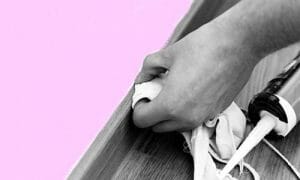 Centipede is a common household pest and can be pretty dangerous to humans. We should eliminate it from our homes because it can cause a lot of damage to our health. As a homeowner, keeping house centipedes out of your bed is essential.
Centipede is a common household pest and can be pretty dangerous to humans. We should eliminate it from our homes because it can cause a lot of damage to our health. As a homeowner, keeping house centipedes out of your bed is essential.
Centipedes don’t just like being inside the house. They also like to come inside the bed. It is because places tend to be warmer than other areas of your home, where bed bugs may find themselves trapped or out of their preferred temperature range.
There are a few methods to keep house centipedes from entering your bed, such as reducing humidity, caulking entry points, eliminating their food source, Reducing habitat, essential oils, boric acid, etc.
What attracts centipedes to your bed?
House centipedes are attracted to damp and wet places and can live in indoor and outdoor spaces.
1. Moist places:
Centipedes are found in damp, dark areas, wet, food, and moisture sources near water bodies. They like to stay in humid places because their body fluids act as natural antifreeze to keep them from freezing. The centipede has a fascinating lifecycle- every time it sheds its skin, it becomes smaller and more vulnerable to predators.
2. Damp areas:
House centipedes are usually found in moist, dark places like kitchens, bathrooms, and other wet areas where they live.
Water sources like water pipes, leaky faucets and showerheads, toilet tanks, and underwater-stained furniture attract the centipedes
3. Decomposing leaves, mulch, and logs:
They can be found due to moist, decaying organic matter such as decomposing leaves, mulch, and rosters. Nocturnal creatures thrive in summer when they feel hotter than usual.
4. Baseboards, behind pictures, and under the cabinet:
They can be found crawling around your baseboards, behind pictures, and in the cupboard under the sink.
How do you enter centipedes into your bed?
House centipedes are known to inhabit dark and moist places like your bathroom, basement, and some crawl spaces.
In the cold, dark, damp environment, house centipedes are known to stay in their underground burrows during winter. They also tend to be active only in the colder months when they need to warm up.
-
-
- They often enter the house through small openings, such as cracks or gaps in the exterior walls, floor, or porch. However, there is a way to repel them–by applying weatherstripping to the exterior of your home. Weatherstripping is typically a rubber sealant that expands when it comes into contact with moisture and contracts.
- If you leave your windows open, they can easily find their way in because they are usually found in humid environments with a high level of oxygen, so they don’t need to come through the door because there are plenty of openings.
- Centipedes are not known for their excellent manners. They will crawl into any opening they can find, which is why your visitors might have brought them in the first place.
- One of the most common ways for bugs to enter your home is through cracks or crevices around doors, windows, and foundation walls. These openings allow water from rain to enter your home. By closing off all entrance points, you can prevent bugs from entering in the first place.
-
How to keep centipedes out of your bed? (Easy control ways)
 1. Caulking all entry points:
1. Caulking all entry points:
The first step to getting rid of a centipede is identifying where they’re coming from. Sealing entryways is the best way to prevent pests from getting inside your home. The tiny insects like to nest on dark, damp surfaces and leave their droppings that can harm you and your family. It is locking the water’s natural flow down the gutter. It could be a potential home for bed bugs. Apply wax or silicone-based sealant to prevent entrances from the outside.
2. Eliminate food sources:
Remove any exposed insects or spiders from your house. Eliminate their food sources. Controlling other insects and spiders inside your home will also control house centipedes crawl because their diet consists of other insects and spiders.
3. Reduce habitat:
Remove organic material from the side of your house. Place firewood, mulch, tarps, and compost bins away from the house’s perimeter and as far away as possible. Remove any compost, leaves, wood, and organic debris. Consider getting rid of damp items like compost bins if possible. Organic materials such as leaves, grass, and weeds can cause issues for your lawn if left to accumulate on the side of your house. Install bathroom fans that can repel centipedes from the bathroom.
4. Keep the bed away from the wall:
Keep the bed away from the wall to make it harder for them to hurry over the bed. Please don’t leave it in a corner where it can still see the wall and feel out for food left there.
If you want to keep your bed free from other insects, seal the mattress with plastic wrap or something similar, or cover it with an old sheet. You don’t need to be picky about all of this, but let’s have a minimum of 1 square inch room around the headboard and 2-3 square inches under it. Use a thick, heavy fabric that won’t move quickly or is easily torn.
5. Keep home dry or reduce humidity:
Keep your home dry by using an air dehumidifier. Clean basements, closets, or other damp areas, and use an air dehumidifier. To eliminate these areas, repair water leaks, use air dehumidifiers to keep basements dry, and install bathroom fans and attics to help eliminate excess moisture.
6. Clean home:
Clean thoroughly, starting with high-traffic areas such as the floor-to-ceiling entryways.· Sweep and vacuum any crumbs and debris into a trash bag or a newspaper for disposal; clean up spills immediately using a wet rag or sponge saturated with dish soap. Vacuum and mop the floors.
6. Make barrier:
Using a 12-24 inch band of gravel or stone around the home’s perimeter, you can create a barrier preventing them from entering the house.
7. Use sticky traps:
Sticky traps will capture not only house centipedes but other household insects. Centipedes are serious pests, and the only method that has been proven to be effective is sticky traps. A sticky trap is made of an absorbent material (often cloth, plastic, or paper) with a small hole drilled. The centipede enters the trap and dies. The trapped centipede will crawl around inside the sticky web until it dies. If you remove the dead centipedes, they will fall to the ground.
8. Eliminate smells that attract centipedes:
The foul smells that attract centipedes are another cause for entering centipedes in your bed. The best way to keep your mattress smelling fresh is by removing all dead or dying bugs that may have fallen into your bed, including house centipedes (if you can find them). Pick up house centipedes crawl from the floor, then take them outside. Centipedes do not crawl under beds or in drawers to lay eggs. They prefer to be out, so throw it out if you find one crawling on your bed or chair.
9. Maintain clutter-free furniture, flooring, and walls:
It would be better to keep centipedes out of your bedroom and not let them into your bedroom. They are tough to remove from the wall, especially when damp or cold outside. They also like to hide in dark corners, and you will have difficulty finding them there. So, it would be best if you tried not leaving any house for centipedes to crawl around your bed or anywhere else they can hide – this could lead to serious health issues. We like to go with our furniture aside from minor changes in the seats and cushions. It’s a good idea for us to keep our flooring, walls, and furniture dust-free through their cleaning. Often, people just don’t get it, leaving their house cluttered with dust and clutter.
10. Frequently wash sheets, blankets, and pillows:
Try to Wash sheets, blankets, and pillows with soap per weak and at least washed first with warm water and a soft brush or sponge.
How to Repel Centipedes Naturally?
Do you have any centipedes in your home? If so, the following are some of the most effective ways to eliminate and eliminate other pests in your home. There are many ways to get rid of house centipedes. Some of the methods include:
 1. Tea tree oil:
1. Tea tree oil:
Tea tree oil can keep centipedes from the bed. It has been widely grown for its repellency against house centipedes and other insects. Mix 25 drops of Tea tree oil with 1 cup of water into a spray bottle. Spray this repellent into your whole bedroom before going to sleep.
2. Mint and Pepper:
Many insects hate the smell scent of mint and avoid it. Add a little cayenne pepper, and those centipedes will stay away. Here is how to repel house centipedes with mint and pepper. Mint essential oils. Just rub it onto the surface before bedtime for the best results. It can repel centipedes by smell.
3. lavender oil:
If you do not have a lifeline, use 1-2 drops of lavender oil in 1 cup EVOO extract or olive oil at a ratio of 2:1 (1 drop every 3 cups). Mix it well and place it on the centipede’s entryways and cracks.
4. Boric acid:
Boric acid works to kill other insects in a couple of different ways. First, the insects ingest the powder, which causes damage to their digestive system and the centipede’s stomach. And intestine. Boric acid also works on their nerve systems, inhibiting the insect’s ability to control its behavior.
5. Essential oil:
Mix 2 cups of water and 24 drops of essential oil and pour into the spray bottle. This oil is a natural repellent when you spray it within your bedroom.
6. Cayenne pepper:
The best way to repel house centipedes is with a mixture of cayenne pepper and the essential oil of your choice, such as lavender, spearmint, or mint. Put the lotion on bug doorways, cracks, and holes you find around the house. Cayenne pepper is one of the most effective natural insecticides. House centipede will avoid cayenne pepper, which is why it is so effective when sprinkled outside the house’s perimeter and along exterior window ledges.
Final word:
The most effective way to get rid of house centipedes is by getting rid of their preferred warm and cozy environment – your bed! If you want to prevent these unwelcome guests from coming into your bed